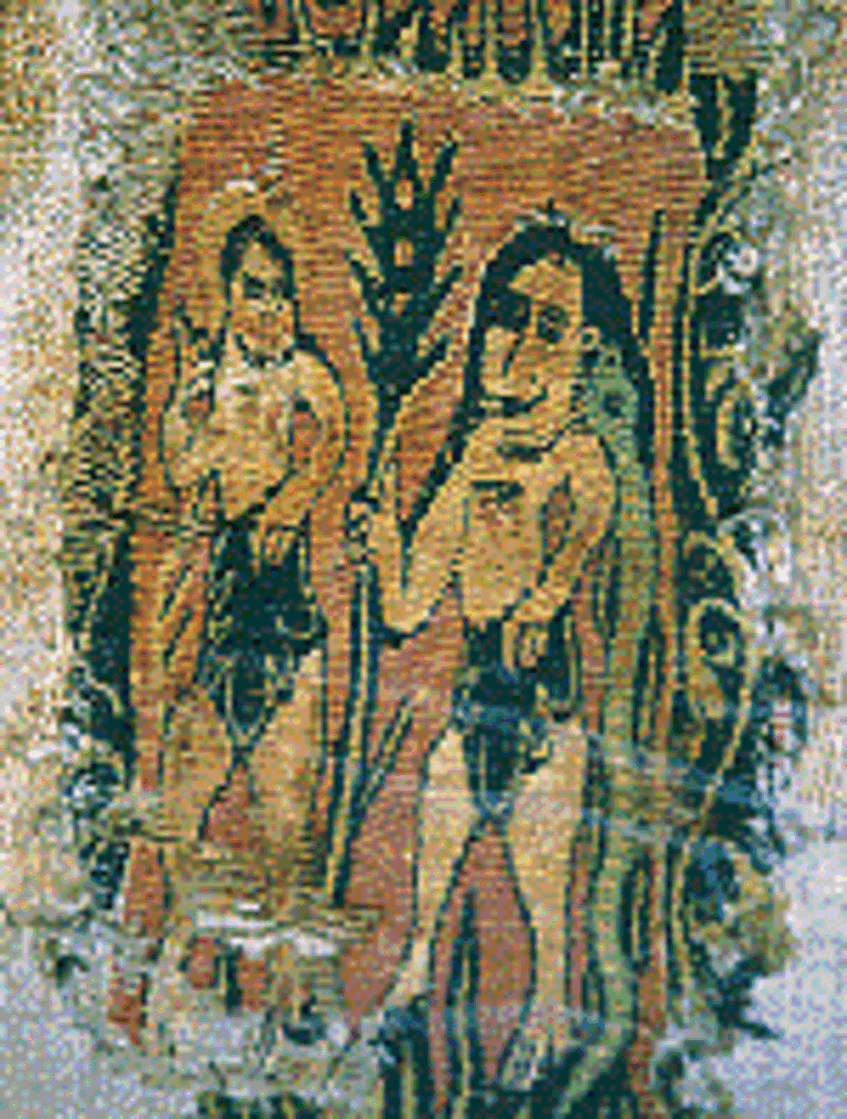Christianity on late antique-early Islamic textiles from Egypt
Project sponsor: Institute for Classical Archaeology
Project leader: R. Pillinger
Collaborators: Dr. V. Drbal (Prague)
Funding: Third-party funds

MAK/Vienna, Inv. T 8528: Detail of a vertical strip of a garment with Adam and Eve after the Fall of Man
Since 2000, the Department of Early Christian Archaeology has been working on so-called Coptic fabrics, primarily in Viennese collections. First and foremost is the Museum of Applied Arts, which today has one of the world's largest collections with around 1208 pieces. In addition to donations and other purchases, the basis for this was formed by Theodor Graf's collection. The Kunsthistorisches Museum was also fed from the same source. The third institution to be mentioned is the papyrus collection of the Austrian National Library. The Höhere Bundeslehranstalt für Mode und Bekleidungstechnik also has an impressive textile collection. There are collaborations with all of these institutions, including in the form of diploma theses and dissertations. Overall, these monuments not only provide information about the clothing of late antiquity, for example in the form of tunics, some of which have been completely preserved, but also about burial customs and trade relations, Egypt as a meeting place for a wide variety of cultures (indigenous Pharonic, Greek-Hellenistic, Roman, Byzantine, Sassanid, etc.) and religious conditions (pre-Christian, Jewish, Christian, Islamic, etc.). Production and restoration data are also of great interest. However, the focus of the research is on the Christian pieces and their cultural and intellectual-historical evaluation.
Publications:
- A. Lirsch, Drei spätantike Clavusfragmente ägyptischer Herkunft aus der Sammlung Tamerit. Ungedr. Dipl. Wien 2001.
- R. Pillinger, Elf Stofffragmente mit Inschriften und christlichen Darstellungen im Museum für angewandte Kunst in Wien, MiChA 7 (2001) 35-42.
- E. Lässig, Ein Tunikafragment mit zwei Clavi, Halsausschnittborte und Orbiculus im Museum für angewandte Kunst in Wien (MAK Inv.-Nr. T 689), MiChA 8 (2002) 9-17.
- Chr. Pflegerl, Ein koptischer Stoff aus der Papyrussammlung der ÖNB (T 34). Ungedr. Dipl. Wien 2002.
- R. Pillinger, Gewandfragment mit menschlichen Figuren und anderen Darstellungen im Museum für angewandte Kunst in Wien. Versuch einer ikonographischen Deutung, MiChA 8 (2002) 18-31.
- U. Horak - E. Lässig, Nimbierte Personen auf sog. koptischen Textilien im Museum für angewandte Kunst in Wien (MAK), MiChA 9 (2003) 65-79.
- E. Lässig, Sogenannte Oranten auf koptischen (spätantik-frühislamischen) Textilien aus Ägypten (eine Auswahl). Ungedr. Dipl. Wien 2003.
- Chr. Pflegerl, Eine spätantike Ärmelborte der Sammlung Tamerit (T34) in der Papyrussammlung der Österreichischen Nationalbibliothek, MiChA 9 (2003) 48-56.
- I. Szabolsc, Untersuchungen an einem bunten Orbiculus der Sammlung Tamerit (Inv.-Nr. T 53). Ungedr. Dipl. Wien 2003.
- E. Lässig, Clavusfragment mit Menschendarstellungen im Museum für angewandte Kunst in Wien (MAK) T 9560, in: H. Harrauer - R. Pintaudi (Hg.), Gedenkschrift für U. Horak (Papyrologica Florentina 34). Firenze 2004, 417-421.
- R. Pillinger, Die Textilkunst der frühen Christen gezeigt am Beispiel der Funde aus Ägypten, in: H. Harrauer - R. Pintaudi (Hg.), Gedenkschrift U. Horak (Papyrologica Florentina 34). Firenze 2004, 429-435.
- Ead., Die Kleidung der frühen Christen an Hand von Originalfunden und Ikonographie, Wiener Humanistische Blätter 46 (2004) 26-46.
- Ead., Klassische Antike in christlicher Deutung gezeigt an Hand ausgewählter Textilien im Wiener Museum für angewandte Kunst (MAK), in: Vis imaginum, Festschrift für E. Walde, Innsbruck 2005, 342-348.
- I. Szabolsc, Untersuchungen von Farbstoffen und Färbemethoden zu spätantiken Stoffen, MiChA 11 (2005) 63-86.
- S. Bilek, Eine Josefwirkerei im Nordböhmischen Museum in Liberec, Tschechische Republik. Ungedr. Dipl. Wien 2006.
- A. Lirsch, Textilien aus spätantiker, frühislamischer und islamischer Zeit in der Antikensammlung des Kunsthistorischen Museums Wien, MiChA 12 (2006) 36-55.
- R. Pillinger, Das nackte Jesuskind, in: E. Christof - G. Koiner - M. Lehner - E. Pochmarski (Ed.), Festschrift für G. Schwarz (VdlG 8). Graz 2007, 309-313.
- B. Bock, Der Kreuznimbus auf so genannten koptischen Stoffen, Ungedr. Dipl. Wien 2008.
- E. Lässig, Musik und Tanz auf spätantiken Textilien aus Ägypten. Eine kunst- und kulturhistorische Studie. Ungedr. Diss. 2008.
- H. Schmid, Der Trauben naschende Hase auf Textilien spätantik-frühislamischer Zeit. Ungedr. Dipl. Wien 2008.
- R. Pillinger, So genannte neutestamentliche Apokryphen auf spätantiken Textilien, in: H. Grieser- A. Merkt (Hg.), Volksglaube im antiken Christentum = Festschrift für Th. Baumeister, Darmstadt 2009, 265–274.
- E. Lässig, Tanz auf spätantiken Textilien aus Ägypten, MiChA 17 (2011) 51-76.
- G. Jaksch, Ausgewählte Pflanzendarstellungen auf Textilien des spätantiken Ägypten. Ungedr. Dipl. 2012.
- E. Lässig, Musikinstrumente auf spätantiken Textilien aus Ägypten, MiChA 18 (2013) 33-60.
- E. von Dellemann, Der Schleier in der frühchristlichen Kunst. Ungedr. Masterarbeit Wien 2013.
- R. Pillinger, The So-called „Constantinian“ Monogram on Late antique Textiles. In: Niš i Vizantija 12 (2014)71 – 76.
- Ead., Bibelrezeption auf spätantiken Textilien, MiChA 20 (2014) 51 – 74.
- M. Eichinger-Wurth, Ein spätantikes Kinderkleid aus Ägypten in der Sammlung der Mode- und Kunstschule Herbststraße in Wien. ungedr. Masterarbeit Wien 2018.
- R. J. Pillinger, Curriculum vitae eines altchristlichen Vorhangs aus der Sammlung Theodor Grafs. MiChA 27 (2021) 111–118.
Prof. (retired) Dr. R. Pillinger (Tel.: 0043 664 2329515)
E-mail: Renate.Pillinger@univie.ac.at
